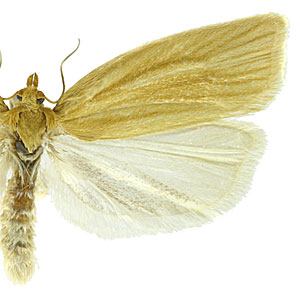Overview

The genus Clepsis contains approximately 150 described species that are distributed throughout the Holarctic, Oriental, and Neotropical regions. Forewing patterns vary within the genus, but many species are brown and marked with a well-defined median fascia and dark costal spot. Male genitalia are characterized by a spatulate uncus and valvae that may be membranous at the apex or have a membranous apical lobe. Female genitalia are characterized by a cestum in the ductus bursae and a signum in the corpus bursae may be present or absent.
Species of economic importance include the Palearctic C. spectrana. In Europe, larvae of this species cause considerable damage to flowing and ornamental plants in greenhouses. The other six species treated here are common non-targets encountered during tortricid surveys. Clepsis peritana is one of the most commonly collected tortricids in the U.S.; it is similar to a number of other Clepsis species, but most can be separated by a combination of male and female morphological characters. For photos of additional non-targets not covered here, visit the Moth Photographers Group link below.
It is difficult to distinguish between different species of Clepsis using larval morphology. As such, most Clepsis larvae intercepted at U.S. ports of entry are not identified beyond the subfamily or genus level. One exception is larvae of C. spectrana, which are commonly intercepted at U.S. ports of entry on peppers (Capsicum) and cut flowers arriving from the Netherlands.
Target species
Clepsis spectrana
Non-target species
Clepsis clemensiana
Clepsis fucana
Clepsis melaleucanus
Clepsis peritana
Clepsis persicana
Clepsis virescana
Links

The following external links require an internet connection. The authors, CSU, CDFA, and USDA/APHIS/PPQ/CPHST are not responsible for the availability or content of these external sites:
Moth Photographers Group - Archipini
References

Bradley, J. D., W. G. Tremewan and A. Smith. 1973. British Tortricoid Moths - Cochylidae and Tortricidae: Tortricinae. The Ray Society, London, England.
Freeman, T. N. 1958. The Archipinae of North America (Lepidoptera: Tortricidae). The Canadian Entomologist Supplement 7 (Vol. 90): 1-89.
Powell, J. A. 1964. Biological and taxonomic studies on tortricine moths, with reference to the species in California. University of California Publications in Entomology. Vol. 32. 317 pp.
Powell, J. A. and P. A. Opler. 2009. Moths of western North America. University of California Press, Berkeley. 369 pp.
Razwoski, J. 1979. Revision of the genus Clepsis Guenee (Lepidoptera, Tortricidae). Part I. Acta Zoologica Cracoviensia. 23: 101-198.
Razowski, J. 2002. Tortricidae of Europe, Vol. 1, Tortricinae and Chlidanotinae. Frantisek Slamka, Slovakia. 247 pp.

